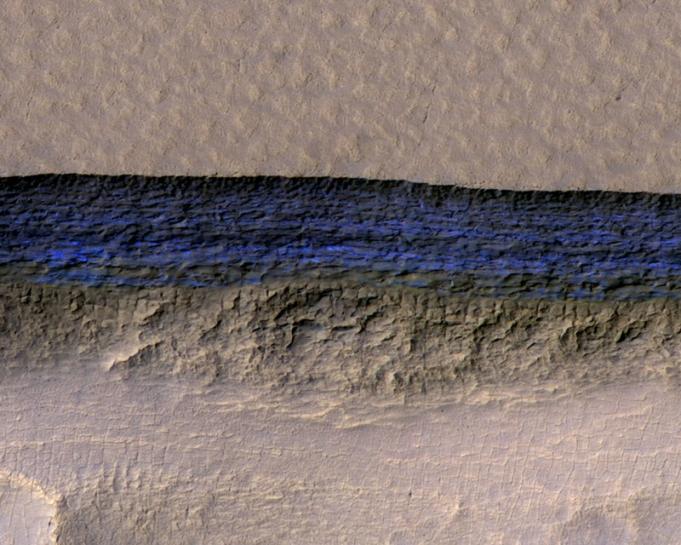Page 9169
Jan 12, 2018
Guns, germs and rice: how the winners of China’s top science prizes point to the future
Posted by Derick Lee in categories: biotech/medical, food, government, science
Weapons developers, disease fighters and food engineers were among the biggest winners in China’s top awards for scientists this year, giving a glimpse of the government’s research priorities.
Awards signal the government’s research priorities for the years to come, analyst says.
Jan 12, 2018
Martian ice deposits could sustain human outposts in the future
Posted by Dan Kummer in categories: futurism, space
WASHINGTON (Reuters) — Scientists using images from an orbiting NASA spacecraft have detected eight sites where huge ice deposits near the Martian surface are exposed on steep slopes, a potential source of water that could help sustain future human outposts.
While scientists already knew that about a third of the surface of Mars contains shallow ground ice and that its poles harbor major ice deposits, the research published on Thursday described thick underground ice sheets exposed along slopes up to 100 yards (meters) tall at the planet’s middle latitudes.
“It was surprising to find ice exposed at the surface at these places. In the mid-latitudes, it’s normally covered by a blanket of dust or regolith,” loose bits of rock atop a layer of bedrock, said research geologist Colin Dundas of the U.S. Geological Survey’s Astrogeology Science Center in Flagstaff, Arizona, who led the study.
Continue reading “Martian ice deposits could sustain human outposts in the future” »
Jan 12, 2018
Tomorrow’s Cargo Drones Won’t Look Much Like Today’s Helicopters
Posted by Dan Kummer in categories: drones, robotics/AI

https://youtube.com/watch?v=xqwS7CcjA28
Boeing unveils a squarish, skeletal quadcopter to try out new unmanned-delivery concepts.
Boeing’s newest prototype drone is a skeletal, squarish quadrotor built as a “flying test bed to mature the building blocks of autonomous technology for future applications,” the aircraft maker said in a statement.
Continue reading “Tomorrow’s Cargo Drones Won’t Look Much Like Today’s Helicopters” »
Jan 12, 2018
The Future of Military IT: Gait Biometrics, Software Nets, and Photon Communicators
Posted by Klaus Baldauf in categories: encryption, military, privacy
DISA director Lt. Gen. Alan Lynn talks about the tech he’s eyeing, some of which is barely out of the theoretical realm.
Tomorrow’s soldiers will wield encrypted devices that unlock to their voices, or even their particular way of walking, and communicate via ad-hoc, software-defined networks that use not radio waves but light according to Lt. Gen. Alan Lynn, who leads the Defense Information Systems Agency, the U.S. military’s IT provider. On Tuesday, Lynn talked about next-generation technologies that DISA is looking into, some of which are barely experimental today.
Here are few of the key areas:
Jan 12, 2018
Could decentralized systems replace Google?
Posted by Klaus Baldauf in category: internet
The internet is ruled by a small number of massive corporations. Roger McNamee, Co-founder of Elevation Partners on CNBC, says, Google, Facebook, Amazon are increasingly just super-monopolies, especially Google … The share of the markets they operate in is literally on the same scale that Standard Oil had … more than 100 years ago—with the …
Jan 11, 2018
Rotation of fast radio burst reveals origins of the cosmic blast
Posted by Dan Kummer in category: space
Jan. 10 (UPI) — By analyzing the unique rotation of FRB 121102, a fast radio burst discovered by Cornell astronomers, scientists have been able to study the nature of its cosmic origin.
While studying the giant pulse of radio waves, researchers realized the waves gyrate, or “twist and shout,” as they pass through a veil of magnetized plasma. The twists represent what’s called Faraday rotation, while the shouts describe the bursts.
By measuring these two phenomena, scientists can better understand the cosmic conditions that inspired the massive pulse of radio waves.
Continue reading “Rotation of fast radio burst reveals origins of the cosmic blast” »
Jan 11, 2018
Uber Air Taxis for the Same Prices as an UberX
Posted by Shailesh Prasad in categories: engineering, transportation
Mark Moore, Uber Engineering Director of Aviation, and Bell Helicopter’s EVP of Technology and Innovation, Michael Thacker, joined Cheddar to break down the new program.
Jan 11, 2018
White graphene makes ceramics multifunctional
Posted by Shailesh Prasad in categories: engineering, nuclear energy
A little hBN in ceramics could give them outstanding properties, according to a Rice University scientist.
Rouzbeh Shahsavari, an assistant professor of civil and environmental engineering, suggested the incorporation of ultrathin hexagonal boron nitride (hBN) sheets between layers of calcium-silicates would make an interesting bilayer crystal with multifunctional properties. These could be suitable for construction and refractory materials and applications in the nuclear industry, oil and gas, aerospace and other areas that require high-performance composites.
Combining the materials would make a ceramic that’s not only tough and durable but resistant to heat and radiation. By Shahsavari’s calculations, calcium-silicates with inserted layers of two-dimensional hBN could be hardened enough to serve as shielding in nuclear applications like power plants.
Continue reading “White graphene makes ceramics multifunctional” »
Jan 11, 2018
Google bought a UK startup that turns screens into speakers
Posted by Shailesh Prasad in categories: computing, media & arts, mobile phones
Over the past year, Google has demonstrated its desire to step up its hardware game. The company bought HTC’s Pixel team for $1.1 billion, designed its own imaging chip for the Pixel 2 and also hired a key Apple chip designer. Bloomberg reports that in its bid to gain an edge on the competition, Google has quietly snapped up UK startup Redux, a small team focused on delivering sound and touch feedback via mobile displays.
According to filings, Google took control of the startup back in August and then subsequently shut down the company’s website. Previous demonstrations show Redux playing back music via a tablet device, which possesses tiny actuators that vibrate the screen and effectively turn it into a loudspeaker. By eliminating the need for smartphone speakers, Google may be able free up more space for batteries and other important components inside future smartphones.

















